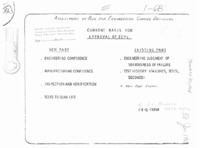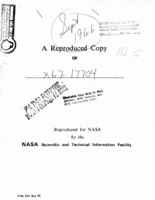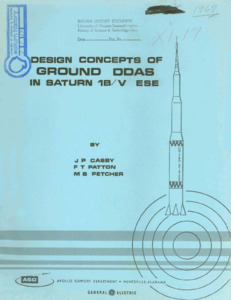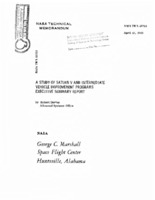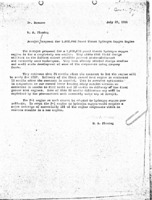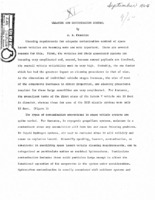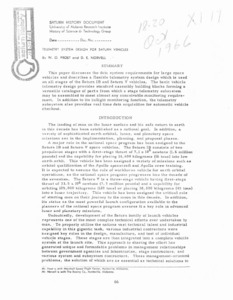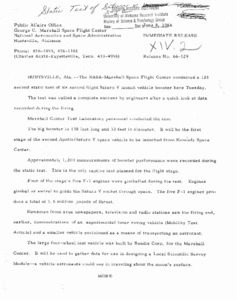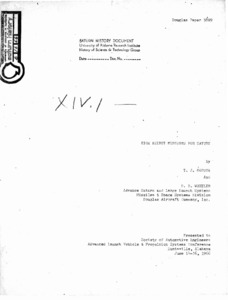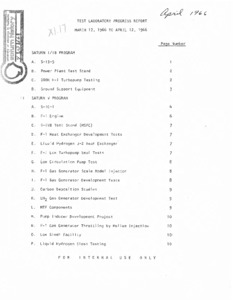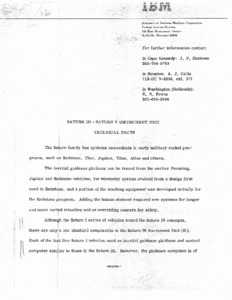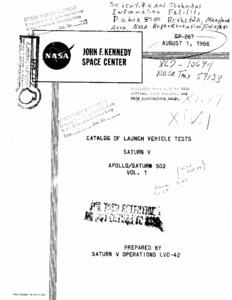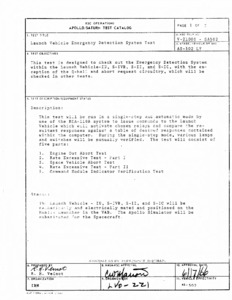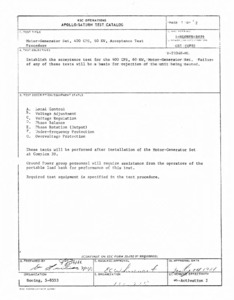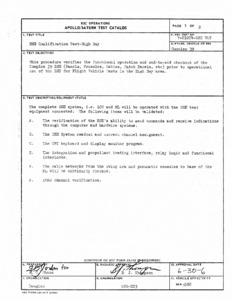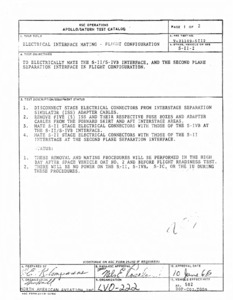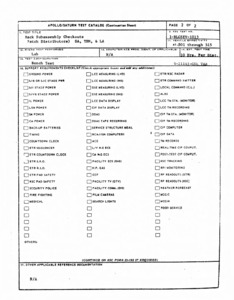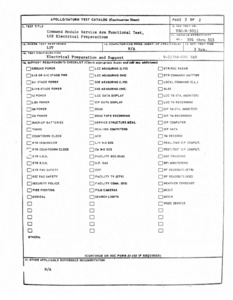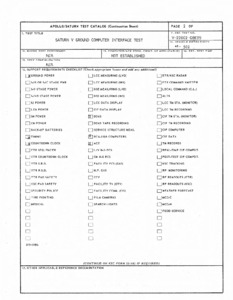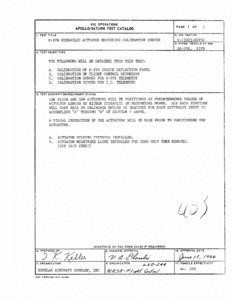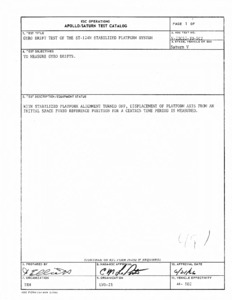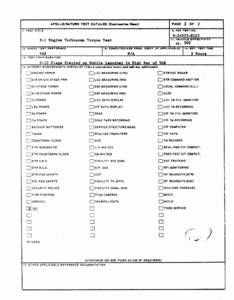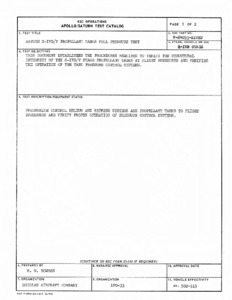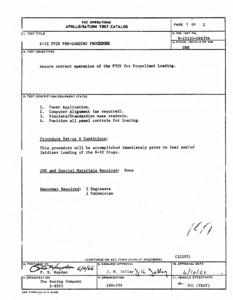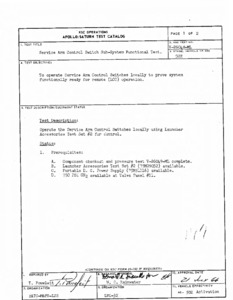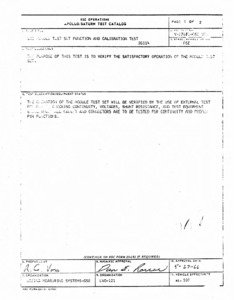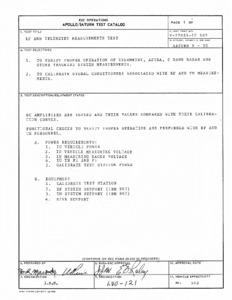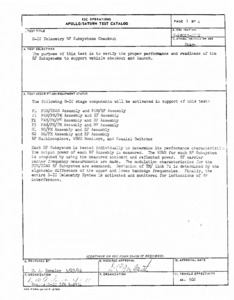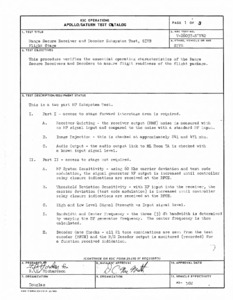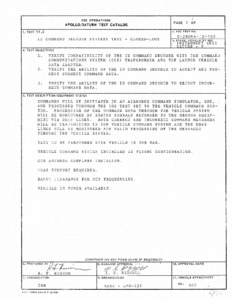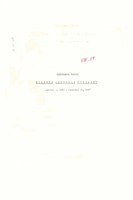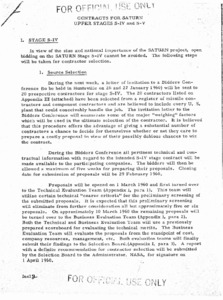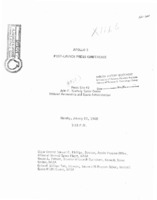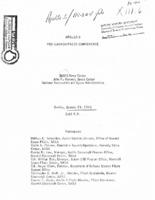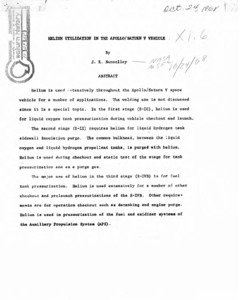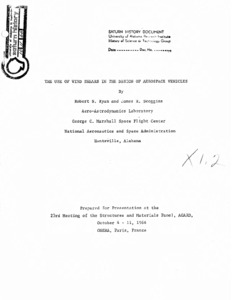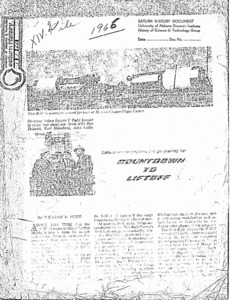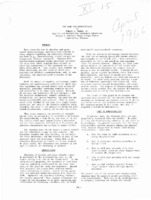
Browse Items (44 total)
Sort by:
-
Differences of configuration in successive Saturn IB and Saturn V vehicles- case 330.
Includes memorandum for file. Configuration matrices reflecting present program status of differences in Saturn IB and Saturn V flight hardware on a mission to mission basis have been prepared. The attached matrices are arranged to show differences in major subsystems (Structures, Propulsion, Instrumentation and Range Safety, and Electrical) for each stage. The reason for the configuration difference and the mission effectivity are included.; DMD, 2031-SGE-eas, GRH; Includes "Recommendation for announcement and distribution of Bellcomm Report". -
"Assessment of Risk for Engineering Change Decisions."
This document includes the current basis for approval of ECPs, fatigue life after stress reduction, and other probability and comparative risk assessments. On the first page there is an inscription, "By E.L. Bombara NASA-MSFC." -
"Application of the Saturn V Launch Vehicle to Unmanned Scientific Exploration of the Solar System."
According to the foreword, "This paper presents the results of a twelve-week mission and systems analysis of a combined Jupiter orbiter/solar probe mission utilizing the Saturn V launch vehicle." -
"Design Concepts of Ground DDAS in Saturn 1B/V ESE."
In the Saturn IB/V programs the sheer quantity of data required for computer processing and ESE display makes it necessary to provide an efficient data acquisition system. For much of the data originating in the launcher this requirement is satisfied by the Ground Digital Data Acquisition System (DDAS). This paper provides a technical description of the Ground DDAS with emphasis placed on the unique design concepts of this telemetry system. -
"A Study of Saturn V and Intermediate Vehicle Improvement Programs Executive Summary Report."
The abstract notes, "The purpose of this report is to summarize the results of three companion studies designed to investigate both the performance growth potential of the Saturn V and the utilization of Saturn V equipment to fill the performance gap in the intermediate payload range between the Saturn IB and the Saturn V. This report includes significant data which is intended to aid the planning of future missions. This data reflects some of the various vehicle configurations which can be used by mission planners to satisfy payload desires in excess of the Saturn IB and Saturn V." -
"Cleaning and Contamination Control."
The document is a paper describing contamination cleaning methods and advocating for further developments in the field. Tables and figures are included at the end of the paper. The figures include a comparison of Saturn V with Saturn I and Saturn IB and cross-sections of the Saturn C-5, S-IC stage fuel tank assembly and oxidizer tank assembly. -
"Telemetry system design for Saturn vehicles."
This paper discusses the data system requirements for large space vehicles and describes a flexible telemetry system design which is used on all stages of the Saturn IB and Saturn V vehicles. The basic vehicle telemetry design provides standard assembly building blocks forming a versatile catalogue of parts from which a stage telemetry subsystem may be assembled to meet almost any conceivable monitoring requirement. In addition to its inflight monitoring function, the telemetry subsystem also provides real time data acquisition for automatic vehicle checkout. -
"Static test of Saturn V S-IC : news release.
Report after second Saturn V flight test. -
"High Energy Missions for Saturn."
Presented to Society of Automotive Engineers, Advanced Launch Vehicle & Propulsion Systems. When the Apollo lunar landing project is complete, the Saturn and Apollo hardware will only have begun to realize their ultimate potential for space exploration. The immense reserve of Apollo technology, facilities, and booster capability can then be directed to the achievement of national goals which lie far beyond the initial lunar landing. In achieving the Apollo lunar objectives, large investments will have been made in launch facilities, tracking systems, propulsion techniques, reentry systems, lunar landing systems and rendezvous technologies. Although developnent in these specialized areas has been tailored to the needs of Apollo, numerous studies by NASA and industry have demonstrated the feasibility of using the spacecraft, launch vehicles, and operating techniques for missions far more complex than lunar landings. Amortization of this hardware will prove cost-effective for missions of more sophisticated applications. -
"Test Laboratory progress report" March and April.
Monthly rogress report for the test laboratory regarding the Saturn 1B program between March and April. -
"Saturn IB - Saturn V instrument unit technical facts."
Press release detailing the technical aspects of the Saturn IB. -
Catalog of launch vehicle tests Saturn V : Apollo/Saturn 502 : Volume 1, Section 1.
The document is Volume 1, Section 1 of a list of Saturn V launch tests including but not limited to test titles, test numbers, test objectives, and test descriptions related to AS-502. -
Catalog of launch vehicle tests Saturn V : Apollo/Saturn 502 : Volume 1, Section 2.
The document is Volume 1, Section 2 of a list of Saturn V launch tests including but not limited to test titles, test numbers, test objectives, and test descriptions related to AS-502. -
Catalog of launch vehicle tests Saturn V : Apollo/Saturn 502 : Volume 1, Section 3.
The document is Volume 1, Section 3 of a list of Saturn V launch tests including but not limited to test titles, test numbers, test objectives, and test descriptions related to AS-502. -
Catalog of launch vehicle tests Saturn V : Apollo/Saturn 502 : Volume 1, Section 4.
The document is Volume 1, Section 4 of a list of Saturn V launch tests including but not limited to test titles, test numbers, test objectives, and test descriptions related to AS-502. -
Catalog of launch vehicle tests Saturn V : Apollo/Saturn 502 : Volume 1, Section 5.
The document is Volume 1, Section 5 of a list of Saturn V launch tests including but not limited to test titles, test numbers, test objectives, and test descriptions related to AS-502. -
Catalog of launch vehicle tests Saturn V : Apollo/Saturn 502 : Volume 1, Section 6.
The document is Volume 1, Section 6 of a list of Saturn V launch tests including but not limited to test titles, test numbers, test objectives, and test descriptions related to AS-502. -
Catalog of launch vehicle tests Saturn V : Apollo/Saturn 502 : Volume 1, Section 7.
The document is Volume 1, Section 7 of a list of Saturn V launch tests including but not limited to test titles, test numbers, test objectives, and test descriptions related to AS-502. -
Catalog of launch vehicle tests Saturn V : Apollo/Saturn 502 : Volume 1, Section 8.
The document is Volume 1, Section 8 of a list of Saturn V launch tests including but not limited to test titles, test numbers, test objectives, and test descriptions related to AS-502. -
Catalog of launch vehicle tests Saturn V : Apollo/Saturn 502 : Volume 1, Section 9.
The document is Volume 1, Section 9 of a list of Saturn V launch tests including but not limited to test titles, test numbers, test objectives, and test descriptions related to AS-502. -
Catalog of launch vehicle tests Saturn V : Apollo/Saturn 502 : Volume 1, Section 10.
The document is Volume 1, Section 10 of a list of Saturn V launch tests including but not limited to test titles, test numbers, test objectives, and test descriptions related to AS-502. -
Catalog of launch vehicle tests Saturn V : Apollo/Saturn 502 : Volume 1, Section 11.
The document is Volume 1, Section 11 of a list of Saturn V launch tests including but not limited to test titles, test numbers, test objectives, and test descriptions related to AS-502. -
Catalog of launch vehicle tests Saturn V : Apollo/Saturn 502 : Volume 1, Section 12.
The document is Volume 1, Section 12 of a list of Saturn V launch tests including but not limited to test titles, test numbers, test objectives, and test descriptions related to AS-502. -
Catalog of launch vehicle tests Saturn V : Apollo/Saturn 502 : Volume 1, Section 13.
The document is Volume 1, Section 13 of a list of Saturn V launch tests including but not limited to test titles, test numbers, test objectives, and test descriptions related to AS-502. -
Catalog of launch vehicle tests Saturn V : Apollo/Saturn 502 : Volume 1, Section 14.
The document is Volume 1, Section 14 of a list of Saturn V launch tests including but not limited to test titles, test numbers, test objectives, and test descriptions related to AS-502. -
Catalog of launch vehicle tests Saturn V : Apollo/Saturn 502 : Volume 1, Section 15.
The document is Volume 1, Section 15 of a list of Saturn V launch tests including but not limited to test titles, test numbers, test objectives, and test descriptions related to AS-502. -
Catalog of launch vehicle tests Saturn V : Apollo/Saturn 502 : Volume 1, Section 16.
The document is Volume 1, Section 16 of a list of Saturn V launch tests including but not limited to test titles, test numbers, test objectives, and test descriptions related to AS-502. -
Catalog of launch vehicle tests Saturn V : Apollo/Saturn 502 : Volume 1, Section 17.
The document is Volume 1, Section 17 of a list of Saturn V launch tests including but not limited to test titles, test numbers, test objectives, and test descriptions related to AS-502. -
Catalog of launch vehicle tests Saturn V : Apollo/Saturn 502 : Volume 1, Section 18.
The document is Volume 1, Section 18 of a list of Saturn V launch tests including but not limited to test titles, test numbers, test objectives, and test descriptions related to AS-502. -
Catalog of launch vehicle tests Saturn V : Apollo/Saturn 502 : Volume 1, Section 19.
The document is Volume 1, Section 19 of a list of Saturn V launch tests including but not limited to test titles, test numbers, test objectives, and test descriptions related to AS-502. -
Catalog of launch vehicle tests Saturn V : Apollo/Saturn 502 : Volume 1, Section 20.
The document is Volume 1, Section 20 of a list of Saturn V launch tests including but not limited to test titles, test numbers, test objectives, and test descriptions related to AS-502. -
Michoud Assembly Facility Historical Report, January 1, 1967-December 31, 1967.
Pages 1 and 2 appear to have been cut out of the document. Page 14 is only half a page. Page 40 is repeated but each page has different information. -
"Contracts for Saturn Upper Stages S-IV and S-V".
Details contracts for upper stages of Saturn IV and Saturn V and includes illustrative appendixes. Archive copy is a photocopy. -
"Apollo 5 Post-Launch Press Conference."
This document contains the transcription from the Apollo 5 post-launch press conference, including all the questions asked and answers given by participants Major General Samuel C. Phillips, Rocco A. Petrone, and Colonel William Teir. -
"Apollo 5 Pre-Launch Press Conference."
This document contains a transcript of the pre-launch conference, including the questions asked and the answers given by participants William C. Schneider, Rocco A. Petrone, George M. Low, Col. William Teir, Col. Royce Olson, Christopher C. Kraft, Jr., and Eugene F. Kranz. -
"Helium Utilization in the Apollo/Saturn V Vehicle."
Helium is used extensively throughout the Apollo/Saturn V space vehicle for a number of applications. The welding use is not discussed since it is a special topic. In the first stage (S-IC), helium is used for liquid oxygen tank pressurization during vehicle checkout and launch. -
"The use of wind shears in the design of aerospace vehicles."
Prepared for presentation at the 23rd Meeting of the Structures and Materials Panel, AGARD, October 4-11,1966, ONERA, Paris, France.; ABSTRACT: The relative influence of various wind profile properties and disturbances on launch vehicle flight dynamic response is studied. Particular emphasis is placed on the influence of wind shears and turbulence on dynamic response during the boost phase of the flight. Four hundred and seven individual detailed (Jimsphere) wind profiles are the primary wind inputs for this analysis. Time response of the vehicle to each profile is computed and a statistical evaluation of the results made. Results are obtained for the Saturn V space vehicle and conclusions drawn as to the relative influence of wind shears and turbulence vs the degree of refinement of the dynamic model of the space vehicle. -
"Countdown to Liftoff".
This is an article from the Boeing Magazine. The Archive copy is a very poor photocopy and is difficult to read.; About the time the S-IC-1 booster is lifting the first Apollo/Saturn V from the launch pad on its maiden unmanned flight next year, a Boeing systems test crew will begin static testing the S-IC-4 at Devils Swamp, Mississippi (MTF). Starting with S-IC-4, all Saturn V first stage boosters will be captive fired at MTF. At present, S-IC firings are conducted by MSFC's test laboratory at Huntsville. The first flight stage, the S-IC-1, was placed in the static test stand on 24 January 1966 and completed its test program 25 Feb. It was removed from the stand March 14 and is undergoing post-firing checkout. it is due to be shipped this summer to KSC where it will be mated to the two upper stages of Saturn V, the IU and Dummy Apollo payload. The S-IC-2 went into the static stand on March 22 and is being tested during April The S-IC-3 also will be tested at Huntsville in 1966. The job of putting the world's largest and most powerful rocket together will be accomplished in the world's largest building, the 52-story vehicle assembly building. -
"The Case for Compatibility."
"The Case for Compatibility" is a paper by Robert L. Smith, Jr., who worked in Quality and Reliability Assurance Laboratory at George C. Marshall Space Flight Center. The summary states, "Ever since the use of missiles and space launch vehicles began, questions have existed in every program regarding the similarity between upstream (e.g., manufacturing, static firing ) and launch site checkout equipment. Programs have existed which utilized nearly identical equipment for both uses; other programs have existed in which any resemblance of the equipment was probably coincidental. Many factors have entered the final decisions, not the least of which were economic and schedule considerations, and, in some instances, the organizational structure of the developer."

